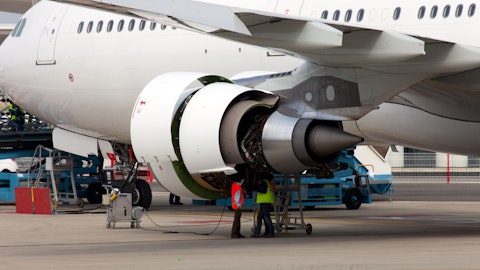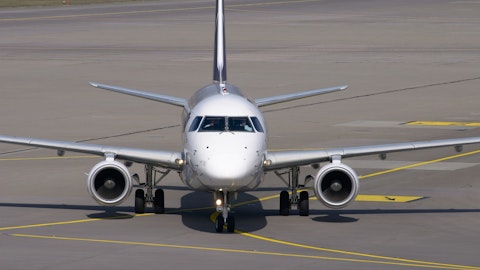So that will reduce our ’24 CapEx. And we know what feedstock commits we had. So we’ve looked at that and said we’re going to bring our CapEx down $100 million. Now that doesn’t mean that’s where we necessarily stop. We’re continuing to scrub that. And we’re going to look for more opportunities to lower the expenditures there as we move forward. I’m sure, Joe, in particular, will be looking at every flow. In terms of the adjusted EBITDA to revise the guidance we gave at the end of September for ’24, because of the situation in Israel, the customer and macro market softness that we’ve mentioned, we want to let that play out further and update that guidance in February. But that said, we are confident that the adjusted EBITDA that we put forward for ’24 will be higher than our ’23 that we’ve guided to.
And we look forward to, in February, once we’ve had some of these events continue to evolve and updating the market further, that we have enough, we believe, visibility to ’24 certainly to say it will improve upon ’23’s result.
Mike Berger: I just want to highlight the one thing that Quint mentioned specifically around Omni is that troop rotations will take place. We just, from a timing standpoint, I can’t predict that piece of it.
Christopher Stathoulopoulos: Right. Okay. So if I hear you, the sort of base case risk-adjusted view, if you will, of EBITDA for next year is higher than, let’s say, the midpoint of — for today’s revised guide?
Quint Turner: Correct.
Christopher Stathoulopoulos: Okay. And last one on the power-by-cycle contracts, Quint, how many of those sort of pandemic-era contracts are rolling off of this year?
Quint Turner: Well, the — what I was speaking of was related to the 767-200 GE-powered 80A engines. And we maintained a pool. You may remember when our previous arrangement for power-by-cycle ended with a supplier, we instead went to a pooling concept, where we would make that power available to lessees for 767-200s. So we have — we provide that availability and customers pay us by the cycle on that. And we maintain that pool of engines, which you can expect, as that 767-200 fleet comes down, our CapEx spend to do that will likewise come down. But what we have seen is, as we’re paid by the cycle, we’ve noted this year that sequentially each quarter, we’ve seen those airplanes that are still out there with customers flying fewer cycles.
And I think that is an indicator that there perhaps some softening market because there aren’t — there isn’t as many flights taking place, not as much perhaps for those customers’ volumes a reason to fly the airplane. And so that has impacted, as I mentioned, the EBITDA from the 200 fleet that [CAM] gave us, but — and I’m not sure, Chris, if you were asking about our own power-by-cycle arrangements that we have with suppliers to maintain other engine types or you were just focusing on the comments around 767-200 PBC.
Christopher Stathoulopoulos: Not the 200s, overall, I’m guessing that you did — there were some contracts that were put together early mid-days of the pandemic. And I was curious how many of those are rolling off at year-end.
Quint Turner: Well, I mean, the other engine types, the other aircraft types and the engines that power them, we don’t maintain a pool of engines. Under the lease, the customer is typically responsible for the maintenance of those engines throughout the life of the lease. Now we ourselves have a power-by-cycle arrangement with an outside vendor to take care of our engines for the 767-300 GE-powered fleet. And I believe we’ve entered into one with IAI for the PW4000s, right, the Pratt engines. But that’s different than us offering a product to a customer. That’s us buying from a supplier. So I’m not sure which side of the PBC you’re getting at there.
Operator: Our next question comes from Howard Rosencrans with Value Advisory.
Howard Rosencrans : So the second half looks like — so the midpoint of your guidance is $270 million. I’m just trying, based on — so the Omni part is largely the Middle East. Is that the big change there?
Quint Turner: That’s — in the fourth quarter, Howard, for Omni, that would be — of the second half, obviously that happened in October, so that’s — in the fourth quarter, yes, that’s the biggest impact on Omni.
Howard Rosencrans : Okay. And the rest of the stuff is lower demand or the absence of the engine sales, just to summarize, right?
Quint Turner: Yes, I mean, we went through some of the puts there a minute ago, puts and takes.
Howard Rosencrans : Right, okay. Just I’m having a little trouble processing. In my 40 years in the business, I never saw this happen. So the $270 million, the midpoint of the guide, should be the absolute, absolute — you already communicated you’ll expect that the guide you’ll introduce or that — ostensibly, 2024 will be higher than 2023. So — but just to take the bare — just to take $270 million as a second half number, you have some anomalies. You have some — you have all of these factors. So sort of a worst-case scenario is that, that suggests that your $540 million, $550 million is the absolute bare bones, just so we can understand what sort of a bare bones number there is out there?
Quint Turner: Well, I think when we said it would be better, we were talking about for our full year ’23. So the full year ’23 guide is higher than $540 million, right? So we’re talking about our guidance for the full year ’23.
Howard Rosencrans : Okay, I thought you were talking about ’24 when you made some comments about ’24. Okay, maybe I’m just…



